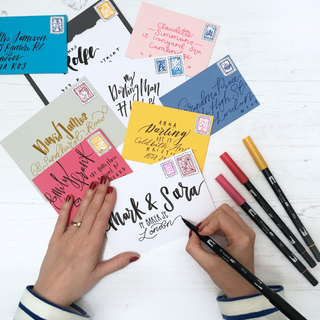In an age where texts and emails are everywhere, receiving a handwritten letter feels truly special. On World Letter Writing Day, we can celebrate this thoughtful tradition, and using calligraphy is a lovely way to make your letter stand out.
Whether you’re a seasoned calligrapher or just starting out, here’s how you can write the perfect letter, with the help of Tombow products.
1. Choose your tools
2. Pick the Perfect Paper
Quality paper is key to ensuring your calligraphy looks its best. You’ll want to choose a smooth, bleed-resistant paper that allows your Tombow pens to glide effortlessly. Consider using heavyweight paper or cardstock for a luxurious feel. If you’re creating a more traditional letter, opt for high-quality writing paper that will hold up well in the post. For a stylish touch, try using our black pad!
3. Plan Your Layout
Before putting pen to paper, take some time to plan your layout. Consider where you want your calligraphy to stand out, such as the recipient’s name, a quote, or a special greeting. Lightly sketch out your design with a pencil, including any flourishes or decorative elements you want to add.
4. Master the Basics of Calligraphy
If you’re new to calligraphy, start by practicing the basic strokes. The Fudenosuke Brush Pens are excellent for beginners as they help you get a feel for creating varying line thicknesses.
Practice basic strokes, letters, and connecting them smoothly.
You can download our printable practice sheets and use those to guide your practice.
Focus on keeping your hand relaxed, using your whole arm to guide the pen rather than just your wrist. This will help you maintain consistency and fluidity in your strokes.

5. Add Your Personal Touch
What makes handwritten letters so special is the personal touch. Whether it’s a heartfelt message, a favourite quote, or a simple greeting, let your personality shine through your calligraphy.

6. Embellish with Decorative Elements
Calligraphy doesn’t have to be limited to just words. Add decorative elements like borders or small illustrations to improve your letter. The Mono Drawing Pens are brilliant for creating doodles, while the ABT Dual Brush Pens can add colour and depth.

7. Seal with style
Once your letter is complete, don’t forget to add a finishing touch to your envelope. Address the envelope in calligraphy and consider adding a wax seal or a decorative stamp to make it truly special.

8. Practise Makes Perfect
Like any skill, calligraphy improves with practice. Use World Letter Writing Day as an opportunity to polish your craft. Whether you’re writing to a loved one or participating in a letter-writing exchange, each letter you create will help you refine your technique.
You can improve your lettering skills by printing our practice sheets or by joining one of our workshops. Subscribe to our newsletter to be the first to know about upcoming sessions!
